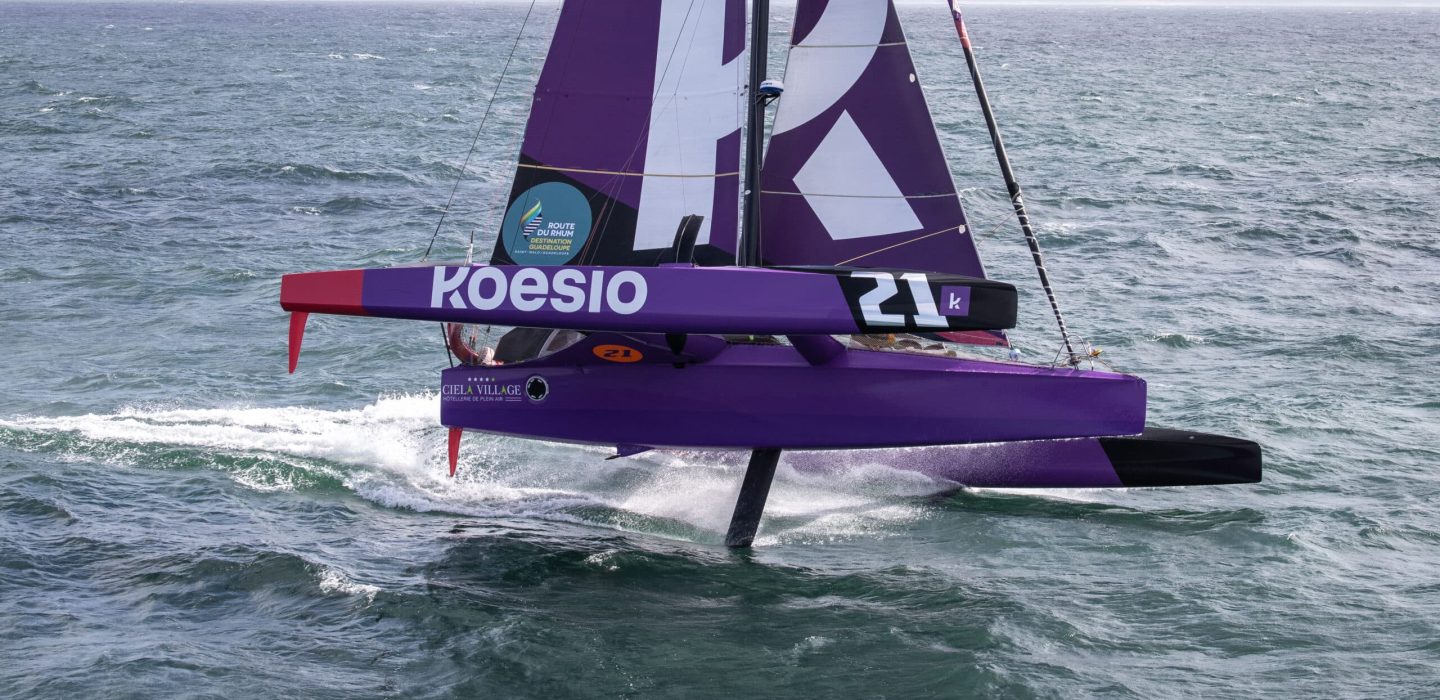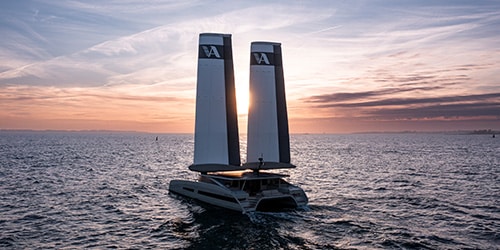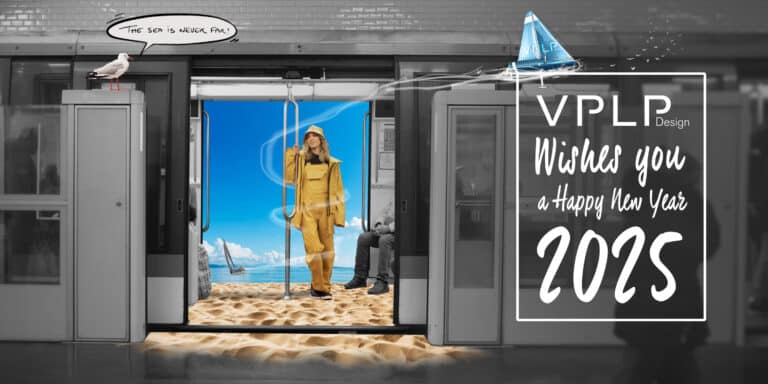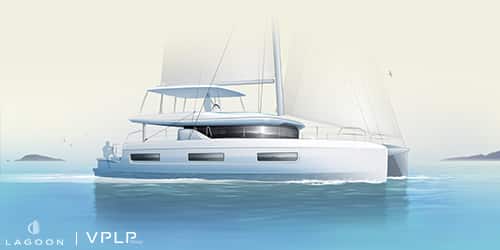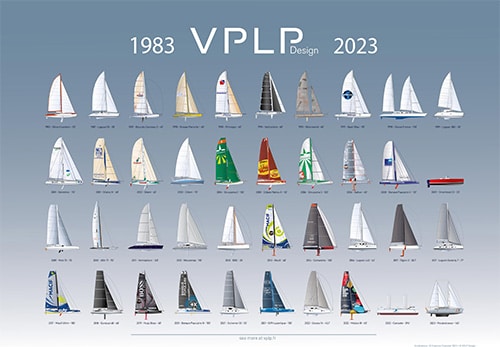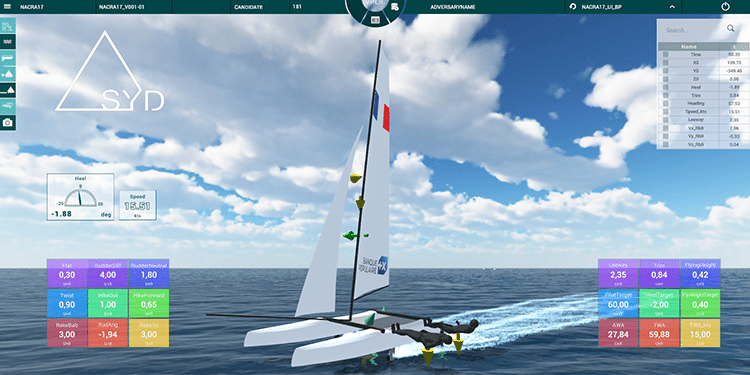With twenty-nine boats crossing the starting line off Saint Malo, VPLP Design was well represented in five of the six categories of this twelfth and latest edition of the Route du Rhum-Destination Guadeloupe. Let’s get an early assessment from partner architects Quentin Lucet and Xavier Guilbaud.
In the lead-up to the race, the 138 boats tied up in Saint Malo marina gave a fine overview of offshore racing history. And of VPLP Design’s expertise too, with the notable presence of Flo, formerly Pierre 1er, which in 1990 treated the firm to its first taste of success in the Route du Rhum with Florence Arthaud at the helm. A Formula 1 back in the day, the sixty-foot trimaran was preparing to sail once again to Guadeloupe, this time with Philippe Poupon at the helm. Her slender appearance alongside today’s beefier Ultims offered a striking comparison in Vauban docks!
And the giants of the Ultim class fought a remarkable battle to secure the top spot in their category, demonstrating “a totally new level of commitment, perhaps that even the skippers themselves would never have imagined at the start,” says Xavier Guilbaud, who worked on almost all the boats in the category, in particular the most recent trimarans SVR Lazartigue and Banque Populaire XI. “The boats spent between 50% and 60% flying above the water and generated a considerable volume of data, which can be leveraged for structural analysis and to recalibrate our digital simulation tools.”
François Gabart came in second behind Charles Caudrelier on Maxi Edmond de Rothschild, launched in 2017, which Gitana Team managed to refine and optimize into a highly competitive boat. As for Armel Le Cléac’h, a broken keel forced him to turn back to Lorient after a single day’s racing. “We’re investigating it in collaboration with the Banque Populaire team,” says Xavier Guilbaud. “We know that with this type of appendage, we’re dealing with pretty big loads. We don’t have an answer yet. Banque Populaire XI and SVR Lazartigue only went into the water last year and are, therefore, still at an early stage in their development. What they’ve shown us on this Route du Rhum is very promising going forward.”
Justine Mettraux confirms her talent,
Koesio is the winning Ocean Fifty
In the IMOCA class the level of commitment was once again exceptional. The race saw Justine Mettraux complete her first ever solo race aboard Teamwork, making a very respectable and universally applauded seventh place. Feasibility studies to update the former Charal are already underway with a view to competing in the next Vendée Globe. Antoine Lauriot Prévost joined the boat for her passage back to Lorient. “The boat is almost in her initial launching configuration, and we’ve mastered new geometries that allow us to extend the scope for using the foils,” says Quentin Lucet.
Unfortunately Malizia-Seaexplorer was unable to compete with the leaders, as she was hampered early on by technical issues and then deprived of her foils in the trade winds. “Beyond the result, the real frustration is not having been able to test this new set-up against the main players in the class,” says the architect. Next stop Alicante in mid-January for the start of The Ocean Race, Boris Herrmann’s main goal.
In the Ocean Fifty class, Erwan Le Roux’s win just under twenty minutes ahead of Quentin Vlamynck is a satisfying outcome for VPLP. The firm designed Koesio for downwind sailing. “We focused on saving weight,” says Quentin Lucet, “making the boat the lightest in the fleet. And Erwan did indeed enjoy extra speed in the trade winds thanks not only to the competitiveness of the boat, but also to his extensive experience sailing her and of the race itself.”
For the next Ocean Fifty, commissioned by Fabrice Cahierc and built in the moulds used for Koesio, the weight advantage will be used to refine even more the aerodynamics and ergonomics aboard. The developments will also benefit Koesio. The efforts to protect the skippers from the elements, a major consideration in the design of the most recent Ocean Fiftys (Koesio and Arkema) also had a positive impact on performance according to Quentin Lucet. This is something Xavier Guilbaud confirms: “The skippers talked about it at the finishing line. It’s obvious that, given the level of commitment and the intense pace, particularly in the first week, those who were better protected from the elements were able to maintain higher average speeds.”
We Explore‘s worthy endeavour
In the Class40 class, VPLP Design made a grand entrance with four Clak40 lining up at Saint Malo. All arrived at Pointe-à-Pitre without any problems, the best placed being Fondation Stargardt (Martin Le Pape), finishing ninth. “The winning formula on the Route du Rhum often involves an architect returning for their second or third time, a yard possessing the experience of several builds, and a mariner having already competed in a transatlantic race. We were left wanting in every department,” says Quentin Lucet. “We chose to design the boat for downwind sailing, and in doing so, we knew that we would have a deficit when the wind was before the beam. Clearly we hadn’t fully realized how important the first part of the race would be, but it’s given us plenty of ideas for improving performance in the future.”
VPLP Design was also present in the Rhum Multi class with the experimental vessel We Explore and her flax-reinforced deck. Skipper Roland “Bilou” Jourdain came close to winning, having crossed the line first, but had to be satisfied with second place after receiving a penalty for removing the engine seal. “The goal was to complete the crossing, but Bilou clearly got into the spirit of the race and pushed his customized Outremer 5X enough to validate the R&D for ocean passage-making. It was a very worthy human and sporting endeavour which starts a new page in the design of tomorrow’s boats,” says Xavier Guilbaud.
